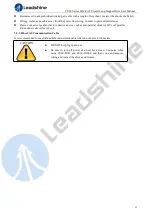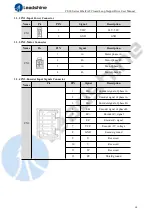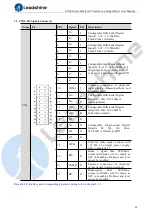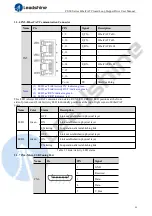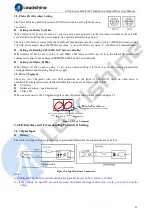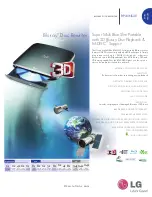
CS3E Series EtherCAT Closed Loop Stepper Drive User Manual
7
1 Introduction
1.1 Product Introduction
The newly released CS3E series drives support CANopen over EtherCAT (CoE) control and CiA 402 operating
modes including Profile Position (PP), Profile Velocity (PV), Homing (HM) and Cyclic Synchronous Position
(CSP). The products can be matched with many brands of EtherCAT controller/PLC such as Beckhoff, Omron,
Trio, Keneyce etc.
The CS3E series is highly reliable and affordable and performs excellently in many industrial applications such as
solar equipment, textile, civil, robotics, power generation equipment, 3C, packaging...
1.2 Features
No loss of step, No hunting, No torque reservation
CANopen over EtherCAT (CoE) with full support of CiA402,100Mbps full-duplex.
Support operation modes: Profile Position, Profile Velocity, Cyclic Synchronous Position, Homing
7 configurable digital inputs, 7 optically isolated digital outputs include brake output
Low noise and vibration, smooth motion
20-50VDC supply voltage for CS3E-D503 and CS3E-D507, max 7A output current
20-72VDC supply voltage for CS3E-D728, max 8A output current
20-80VAC or 30-100VDC supply voltage for CS3E-D1008, max 8A output current
USB port for parameters configuration
Encoder resolution: 1000 / 2500 / 5000 line for NEMA11/17/23/24/ 34 CS motors,
Two 7-segment display velocity or slave ID or operation mode or error code
Protections for over voltage, over current and position following error, encoder cable error, etc.
1.3 EtherCAT Compare with Step/Direction
1.3.1 Stronger anti-disturbance ability
Traditional step/direction transmission cables have lower reliability for the reason of EMC interference, whereas
EtherCAT communication with shielded cables have stronger anti-interference ability, and inbuilt error detection.
Limit and handling mechanisms can also bring more reliable transmission and longer communication distance.
1.3.2 Enhanced performance
EtherCAT is the fastest industrial Ethernet technology by and large,and it also synchronizes with nanosecond
accuracy. This is a huge benefit for all applications in which target system is controlled or measured via the bus
system.
1.3.3 Simple wiring and long communication distance
In step/direction control mode, the controller/PLC needs to connect with each drive to send control signals, which
may lead to intensive signal cables and wiring complexity if many drives are required. While in EtherCAT
applications, the controller/PLC just needs to connect with one of the drives and then line topology with others.
Additionally, the EtherCAT communication allows longer distance up to 100 meters maximum.
1.3.4 Lower cost
EtherCAT delivery has the features of industrial Ethernet at a price similar or even below that of traditional
control mode. The only hardware required by the master device is an Ethernet port, instead of some expensive
interface cards or co-processors. Since EtherCAT doesn’t require high-speed pulse modules or other active
infrastructure components, the costs for these components and their installation, configuration, and maintenance
are also eliminated.

















